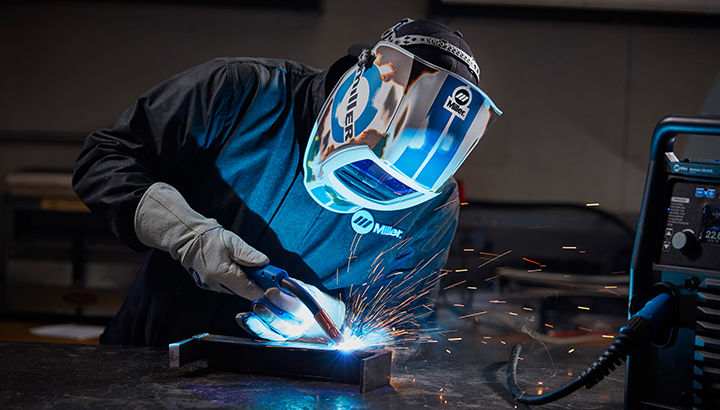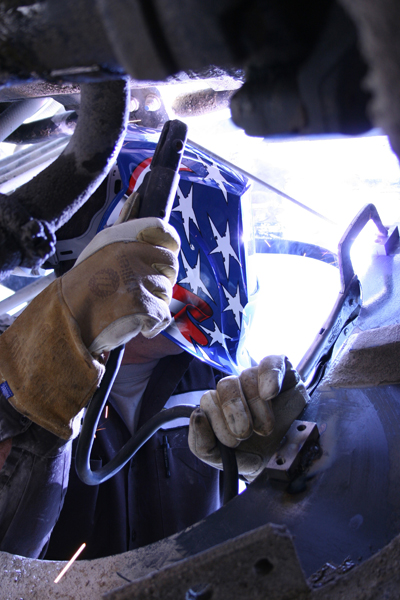Typical Welding Repair Work Issues and How to Address Them Effectively
Welding fixings often experience an array of concerns that can jeopardize the honesty of the last item. Usual issues include inadequate penetration, porosity, and imbalance, to name a few. Each flaw presents distinct difficulties that call for certain methods for resolution. Recognizing these concerns is necessary for welders intending to enhance their results and skills. This discussion will certainly check out these common welding repair issues and effective techniques to address them.
Insufficient Infiltration
Insufficient infiltration occurs when the weld steel falls short to completely fuse with the base product, leading to weak joints and possible structural failings. This problem typically stems from insufficient warmth input, incorrect electrode angle, or inappropriate welding rate. Welders might experience insufficient infiltration as a result of a miscalculation of the required specifications for a certain product thickness or type. In addition, contamination on the base product's surface area can impede effective bonding, intensifying the issue. To resolve poor infiltration, welders ought to guarantee proper setups on their devices and preserve a tidy work surface area. Normal examination of welds is suggested to determine any type of deficiencies early, permitting for timely modifications and the prevention of jeopardized architectural integrity in bonded assemblies.
Porosity
Porosity is an usual flaw in welded joints that materializes as tiny gas bubbles entraped within the weld steel. This defect can jeopardize the stability of the weld, bring about decreased toughness and possible failing under anxiety. Montana Mobile Welding and Repair Fabrication. Porosity usually emerges from contamination, dampness, or incorrect welding techniques, which allow gases to leave right into the liquified weld swimming pool. To address porosity, welders need to guarantee proper surface prep work, preserve a clean workplace, and make use of suitable welding specifications. In addition, selecting the ideal filler product and securing gas can mitigate gas entrapment. Routine assessment and screening of welds can help determine porosity early, assuring timely corrective activities are taken, thus maintaining the quality and dependability of the welded framework
Misalignment
Imbalance in welding can emerge from different aspects, consisting of improper setup and thermal development. Recognizing the origin is crucial for efficient resolution. Numerous adjustment strategies are offered to realign parts and assure structural integrity.
Reasons of Misalignment
Welding misalignment frequently comes from a selection of underlying concerns that can compromise architectural honesty. One key cause is improper fit-up of parts prior to welding, which can bring about voids and irregular surfaces. Variants in thermal growth during the welding procedure can also result in distortion, especially if the products being signed up with have various coefficients of development. Additionally, inadequate fixturing and securing may fail to hold components safely in place, resulting in movement during welding. Poorly conserved tools, consisting of welding machines and devices, might introduce variances in the weld bead, more adding to misalignment. Lastly, driver error, stemming from inadequate training or experience, can likewise play a significant duty in producing misaligned welds.
Improvement Techniques Available
Addressing misalignment effectively needs a mix of corrective strategies tailored to the certain issues at hand. One usual method is the use of jigs or fixtures to hold elements in the proper placement throughout welding, making sure regular positioning. Additionally, pre-heating the materials can help in reducing distortion and enhance fit-up. For substantial imbalance, mechanical realignment methods, such as making use of hydraulic jacks or clamps, can be used to fix the position before welding. Post-weld warm therapy may additionally be required to soothe stresses brought on by imbalance. Careful examination and change during the configuration stage can protect against misalignment issues from ending up being considerable troubles, advertising a smoother welding process and improving total architectural integrity.
Distortion
Distortion is a common difficulty in welding that can arise from numerous variables, including uneven cooling and heating. Comprehending the reasons for distortion is necessary for applying efficient avoidance techniques. Addressing this issue not just boosts structural integrity yet likewise enhances the overall high quality of the weld.
Causes of Distortion
When based on the intense heat of welding, materials typically undergo changes that can result in distortion. This sensation primarily arises from thermal development and tightening during the welding process. As the weld location warms up, the product broadens; upon cooling, it acquires, which can create interior anxieties. Additionally, uneven heating throughout a work surface can exacerbate these anxieties, leading to warping or bending. The kind of product likewise plays a significant role; steels with varying thermal conductivity and coefficients of development might respond in different ways, causing uncertain distortions. Poor joint layout and insufficient fixturing can add to imbalance throughout welding, raising the likelihood of distortion. Recognizing these causes is necessary for effective welding repair and prevention methods.
Prevention Techniques
Effective avoidance strategies for distortion throughout welding concentrate on controlling heat input and making sure appropriate joint layout. Maintaining a constant heat input aids to minimize thermal growth and tightening, which can cause distortion. Utilizing techniques such as preheating the workpiece can also minimize the temperature gradient, promoting uniform heating. Furthermore, picking suitable joint styles, such as T-joints or lap joints, can improve security and reduce stress concentrations. Implementing appropriate fixturing to protect the work surfaces in area further aids in maintaining positioning during the welding process. Staggered welding series can disperse heat much more evenly, avoiding local distortion. By applying these approaches, welders can considerably lower the likelihood of distortion and improve the total high quality of their welds.
Breaking
Splitting is a typical issue run into in welding repairs, commonly arising from various tungsten electrode aspects such as inappropriate air conditioning rates, material option, or insufficient joint prep work. The incident of cracks can significantly jeopardize the stability of the weld, leading to potential failures throughout operation. To resolve this problem, welders must first analyze the source, making sure that products work and appropriately chosen for the particular application. Furthermore, managing the cooling price during the welding process is essential; quick cooling can induce tension and result in cracking. Proper joint layout and preparation likewise add to minimizing the risk. Applying these methods can improve weld quality and sturdiness, ultimately decreasing the likelihood of cracking in ended up weldments.

Insufficient Combination
A substantial issue in welding fixings is incomplete fusion, which takes place when the weld metal does not appropriately bond with the base product or previous weld passes - Belgrade Fabrication. This issue can result in weaknesses in the joint, possibly compromising the integrity of the welded framework. Factors contributing to insufficient fusion include not enough warm input, incorrect welding pop over to this site method, and contamination of the surfaces being joined. To address this issue efficiently, welders need to guarantee appropriate pre-weld cleaning and surface area preparation, in addition to readjust their welding criteria to attain appropriate infiltration and combination. Normal examination during the welding procedure can additionally assist identify incomplete combination early, enabling prompt rehabilitative measures to improve the general quality of the weld
Overheating
While welding repair services can enhance architectural integrity, overheating offers a substantial obstacle that can cause product deterioration. Extreme heat throughout welding can modify the mechanical buildings of steels, leading to lowered strength, increased brittleness, and warping. This phenomenon is particularly important in high-stress applications where architectural integrity is extremely important. Recognizing overheating can entail aesthetic assessments for staining or distortion, along with keeping an eye on temperature during the welding procedure. To reduce the threats associated with overheating, welders must use appropriate techniques, such as regulating warmth input, readjusting traveling rate, and making use of suitable filler products. Furthermore, executing pre- and post-weld warmth therapies can help bring back material residential properties and boost the overall quality of the fixing, making certain long-lasting performance and safety.
Regularly Asked Questions
What Are the Usual Indicators of a Welding Issue?

Just How Can I Test My Welds for Quality?
To examine welds for top quality, one can make use of aesthetic evaluations, ultrasonic testing, and radiographic approaches. Each strategy assures structural stability, determines defects, and validates adherence to defined standards, eventually boosting the reliability of the welded joints.
What Safety Safety Measures Should I Take While Welding?
When welding, one must prioritize safety by using proper personal protective equipment, making sure proper ventilation, protecting flammable products away, maintaining a tidy office, and recognizing surroundings to protect against mishaps and browse around these guys injuries.
Can I Repair a Weld Without Redoing the Entire Joint?
Repairing a weld without renovating the entire joint is feasible, depending on the damage (Montana Mobile Welding and Repair). Strategies such as grinding, including filler material, or using a welding procedure can properly resolve details problems while protecting the surrounding framework
What Devices Are Crucial for Reliable Welding Fixes?
Important devices for efficient welding fixings consist of a welding equipment, wire brush, grinder, protective equipment, clamps, and filler materials. Each device plays a crucial role in guaranteeing top quality and safety and security throughout the repair service process. Porosity normally arises from contamination, wetness, or inappropriate welding strategies, which allow gases to get away right into the molten weld pool. Poorly maintained tools, consisting of welding machines and devices, may introduce variances in the weld grain, more adding to imbalance. When subjected to the intense warmth of welding, materials often undertake changes that can lead to distortion. Cracking is an usual problem encountered in welding fixings, frequently resulting from numerous elements such as inappropriate air conditioning prices, product choice, or poor joint prep work. A significant problem in welding fixings is insufficient blend, which occurs when the weld metal does not properly bond with the base material or previous weld passes.
Comments on “Fast fixes to weld misalignment in Montana Mobile Welding and Repair Fabrication”